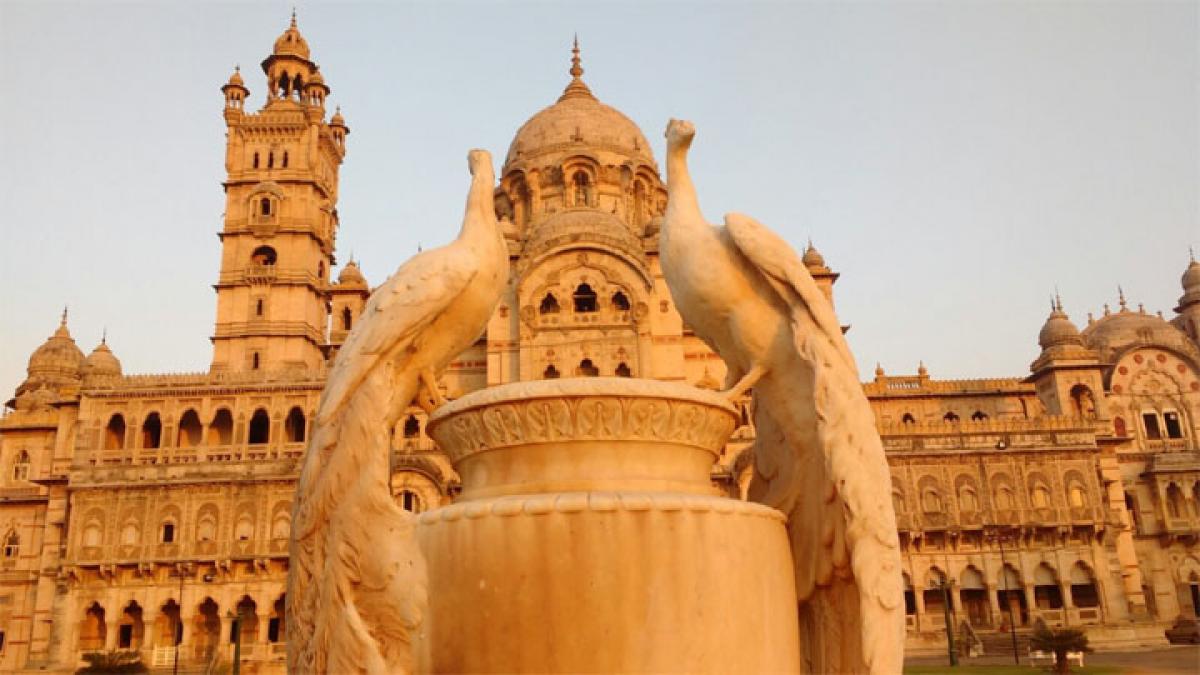Live
- Lavanya Tripathi's Birthday Gift: Title Announcement of Her New Film ‘Sathi Leelavathi’
- Kerala Hindu leader gifts Rig Veda to Pope Francis
- OakTree School Celebrates Eight Years of Success, Announces Future Expansion
- Why plant-based milks may not be healthy
- Jharkhand: Ayushman Bharat cards in demand, Sahebganj residents rush to the centre
- Supreme Court likely to pass directions on implementation of policy to curb air pollution in Delhi-NCR tomorrow
- The first day of Group-2 Paper 1, 2 exams in Wanaparthy district ended peacefully, said Additional Collector Revenue G. Venkateswarlu
- VP Dhankhar urges corporates to invest in education
- Punjab DGP, MHA official request farmer leader Dallewal to end 20-day fast
- Stage Collapse During Swearing-In Ceremony of KUDA chairman in Kakinada
Just In

India is no stranger to palaces. Whether in the north - Rajasthan in particular - or in the south, we can never tire of marvelling at the beautiful architectural remnants of the royal past. Even so, the Lukshmi Vilas Palace in this cultural and educational capital of Gujarat stands out.
India is no stranger to palaces. Whether in the north - Rajasthan in particular - or in the south, we can never tire of marvelling at the beautiful architectural remnants of the royal past. Even so, the Lukshmi Vilas Palace in this cultural and educational capital of Gujarat stands out.
It has the distinction of having the largest number of stained glass paintings, and some of the Gothic-inspired statues leave you wondering if you are in an Indian palace at all! A fine example of Indo-Saracenic architecture, the 125-year-old Lukshmi Vilas Palace has all the ingredients to make it a must-visit on a visitor's itinerary.
Claimed to be the biggest "private dwelling" of its kind, the Luskhmi Vilas Palace was built by Maharaja Sayajirao Gaekwad in 1890. Major Charles Mant, who was the chief architect, kept in mind that the palace must have the traditional touch - and so the three distinct quarters for the ruler, the ladies, and the public. But, given the erstwhile royal family's increasing western lifestyle and large number of European visitors, it also has stately dining rooms, billiard rooms and the like.
The entire palace is not open to visitors as parts of it are still occupied by the erstwhile royal family. The entry is from the rear of the palace for visitors, who are bound to be mesmerised by the well-maintained architectural marvel right from the start. A small courtyard, lush with big plants, leads to front porch from where starts the tour.
It is pertinent to mention here is that unlike many other historical sites where one may be pestered by people posing as guides, at Lukshmi Vilas, you are given an audio system to take you through the palace and explain everything in detail.
The hall that you enter from the front porch is an east-meets-west kind of amalgamation. A statue that occupies the pride of place in the centre has a distinct Gothic influence, a pristine white sculpture right in front indicates classical European art and statues of musicians with Indian instruments on the sides brings you right back home. Everything is beautifully put together, with Belgian stained glass all around.
As your audio-guide tells you, all the woodwork used in the palace is genuine teak. As with the art, the materials used for the architecture are also an east-west blend. The sandstone came from Agra, the blue trapstone from Poona (now Pune) and the marble inlay work and trellises are of the same variety as Michelangelo used for his David sculpture. It's a lot to absorb as you take in the bronze statues, the Felicci statues, statues made with Italian marble and intricate railings.
The armament and weaponry display room throws you completely off guard, especially after the simple reception room with a few larger-than-life portraits of the Gaekwad rulers. Showcasing an impressive collection of swords, daggers, guns and rifles, "most of which have been used in battles", the room also has on display the sword that the Mughal emperor Aurangzeb used.
Another feast for the eyes is the Gaddi Room which is a large space, mostly bare, but has a simple white throne with a peacock feather to coronate the next in line. Where the visual feast lies are the walls, adorned with nine paintings of the famous Indian artist, Raja Ravi Varma. The room, therefore, although simple, entices you to spend more time as each painting narrates a story hidden among the fine strokes.
Probably the most admired section of the Lukshmi Vilas Palace is the Durbar Hall, a vast space with a Venetian mosaic floor, Belgian stained glass windows through which the sunlight filters in and walls with intricate decorations. Outside the Durbar Hall is an Italian courtyard of fountains.
The 700-acre palace compound also has a Sunken Garden, a kind of amphitheatre with a few steps leading down to a large platform, as well as the Maharaja Fatehsingh museum.
The awe that the Lukshmi Vilas inspires stays with you as you leave the palace. Everywhere you look, the palace compound has beautiful sculptures, and then, right at the end, there is a fresco of a royal wedding on the palace's exterior wall. Lukshmi Vilas promises not to leave your mind long after you have left.

© 2024 Hyderabad Media House Limited/The Hans India. All rights reserved. Powered by hocalwire.com







